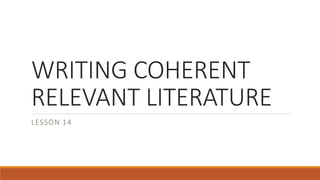Lesson 14 writing coherent review of literature
•Download as PPTX, PDF•
7 likes•20,707 views
PRACTICAL RESEARCH 2 POWERPOINT
Report
Share
Report
Share

Recommended
Recommended
More Related Content
What's hot
What's hot (20)
THE IMPORTANCE OF QUALITATIVE RESEARCH ACROSS FIELDS OF.pptx

THE IMPORTANCE OF QUALITATIVE RESEARCH ACROSS FIELDS OF.pptx
Chapter 4 Understanding Data and Ways to Systematically Collect Data

Chapter 4 Understanding Data and Ways to Systematically Collect Data
Qualitative Research Chapter 3 g11 Research Method and Procedures

Qualitative Research Chapter 3 g11 Research Method and Procedures
3. learning from other and reviewing the literature

3. learning from other and reviewing the literature
Lesson 16 illustrating and explaining conceptual framewok

Lesson 16 illustrating and explaining conceptual framewok
Strategies on How to Infer & Explain Patterns and Themes from Data

Strategies on How to Infer & Explain Patterns and Themes from Data
ARALIN 8 MGA KATANGIAN AT URI NG PANANALIKSIK.pptx

ARALIN 8 MGA KATANGIAN AT URI NG PANANALIKSIK.pptx
Similar to Lesson 14 writing coherent review of literature
Similar to Lesson 14 writing coherent review of literature (20)
BUSI 610Literature Review Title Page and Outline Rubric(50 P.docx

BUSI 610Literature Review Title Page and Outline Rubric(50 P.docx
More from mjlobetos
More from mjlobetos (20)
Lesson 28 drawing logical conclusions from research findings

Lesson 28 drawing logical conclusions from research findings
Lesson 27 using statistical techniques in analyzing data

Lesson 27 using statistical techniques in analyzing data
Lesson 26 presenting and interpreting data in tabular and graphical froms

Lesson 26 presenting and interpreting data in tabular and graphical froms
Lesson 21 designing the questionaire and establishing validity and reliabilty

Lesson 21 designing the questionaire and establishing validity and reliabilty
Lesson 20 describing sample size and sampling procedures

Lesson 20 describing sample size and sampling procedures
Lesson 9 citing benefits and beneficiaries of research study

Lesson 9 citing benefits and beneficiaries of research study
Lesson 4 designing a research usefu; in daily life

Lesson 4 designing a research usefu; in daily life
Recently uploaded
9953330565 Low Rate Call Girls In Rohini Delhi NCR

9953330565 Low Rate Call Girls In Rohini Delhi NCR9953056974 Low Rate Call Girls In Saket, Delhi NCR
KSHARA STURA .pptx---KSHARA KARMA THERAPY (CAUSTIC THERAPY)————IMP.OF KSHARA ...

KSHARA STURA .pptx---KSHARA KARMA THERAPY (CAUSTIC THERAPY)————IMP.OF KSHARA ...M56BOOKSTORE PRODUCT/SERVICE
Organic Name Reactions for the students and aspirants of Chemistry12th.pptx

Organic Name Reactions for the students and aspirants of Chemistry12th.pptxVS Mahajan Coaching Centre
Recently uploaded (20)
EPANDING THE CONTENT OF AN OUTLINE using notes.pptx

EPANDING THE CONTENT OF AN OUTLINE using notes.pptx
9953330565 Low Rate Call Girls In Rohini Delhi NCR

9953330565 Low Rate Call Girls In Rohini Delhi NCR
KSHARA STURA .pptx---KSHARA KARMA THERAPY (CAUSTIC THERAPY)————IMP.OF KSHARA ...

KSHARA STURA .pptx---KSHARA KARMA THERAPY (CAUSTIC THERAPY)————IMP.OF KSHARA ...
18-04-UA_REPORT_MEDIALITERAСY_INDEX-DM_23-1-final-eng.pdf

18-04-UA_REPORT_MEDIALITERAСY_INDEX-DM_23-1-final-eng.pdf
Framing an Appropriate Research Question 6b9b26d93da94caf993c038d9efcdedb.pdf

Framing an Appropriate Research Question 6b9b26d93da94caf993c038d9efcdedb.pdf
Hierarchy of management that covers different levels of management

Hierarchy of management that covers different levels of management
Incoming and Outgoing Shipments in 1 STEP Using Odoo 17

Incoming and Outgoing Shipments in 1 STEP Using Odoo 17
Organic Name Reactions for the students and aspirants of Chemistry12th.pptx

Organic Name Reactions for the students and aspirants of Chemistry12th.pptx
Capitol Tech U Doctoral Presentation - April 2024.pptx

Capitol Tech U Doctoral Presentation - April 2024.pptx
Lesson 14 writing coherent review of literature
- 2. Putting together the Literature Review > Reviewing the literature requires the ability to do multiple tasks from finding and evaluating relevant material to synthesizing information from various sources: from critical thinking to paraphrasing; evaluating and citation skills. > Reviewing the literature is challenging. A good review does not just summarize the literature but discusses it critically, identifies methodological problems and prints out research gaps.
- 3. What is a COHERENCE? > Coherence directs to a well-organized and unified piece of writing. > It also refers on how well a manuscript holds together as a unified document. It is important to ask yourself how well the elements of your review connect with one another. > Transitional expressions and other kinds of rhetorical markers also help to identify the connection among the different sections as “ in the next example” or “ in a related study”, the most recent finding in the study. > Use “First, Second and Third” at the beginning of your paragraphs to mark the development of the related points.
- 4. Sections of a Literature Review > INTRODUCTION ◦ The introduction to the literature review is often a single paragraph that: ◦ > introduces the general topic and provides an appropriate scholarly or societal context for the review. ◦ Identifies the overall state of knowledge about the topic (conflicts in theory, methodology, evidence and conclusions; gaps in research)
- 5. Sections of a Literature Review > BODY ◦ Address previous research on the topic, grouped according to theme, theoretical perspective, methodological approach, chronological development; ◦ Draw together the significance of previous, individual studies by highlighting the main themes, issues and knowledge gaps. ◦ Use strong umbrella sentences at the beginning and end of each paragraph. ◦ Include brief “so what” sentences at intermediate points in the review to connect the literature to the proposed research objectives ◦ Described previous work you have accomplished related to the proposed research.
- 6. Sections of a Literature Review > CONCLUSION ◦ Provides a summary statement of the overall state of knowledge about the topic, including gaps in knowledge and understanding, reconnecting to your introduction. ◦ Reinforces the research purpose or objectives and establishes to the potential significance or importance of your proposed research, relative to the current state of knowledge.
- 7. Sample of Coherent Literature Review